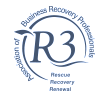The decline and recovery curve of business rescue

When it comes to business distress and recovery, things often get worse before they get better. However, caught early enough, a company can be steered away from insolvency and guided towards a successful turnaround by a qualified business recovery expert.
Just as a company rarely goes from profitable to insolvent overnight, the recovery process is likewise a gradual process. While all companies are different, and the reasons for their financial distress likewise individual to them, there are certain key stages many struggling businesses go through.
1) Off Budget
Contrary to popular belief, a company is not just as risk of decline when it begins to experience falling sales or dwindling profits. While things may look rosy on the outside, there are often warning signs within the business that it could be in a potentially risky position even when trade is seemingly good. Be aware of the dangers associated with overtrading and going off budget, and take steps to ensure your business is not overcommitting itself. It can be difficult to turn down a large order, however, if your company does not have adequate time, cash flow, or resources to appropriately handle this work, taking it on could be perilous to its long-term viability. When a company is in danger of pushing itself close to the financial edge
2) Underperformance and Losses
Once a company’s performance begins to dip and financial losses are incurred, it can be a slippery slope to more serious problems if action is not taken to rectify this period of underperformance. The problem faced by many companies at this stage, is that the initial signs of underperformance are notoriously difficult to spot. It is often a multitude of small failings rather than one momentous event which is to blame for the lacklustre performance. As well as the obvious factors of turnover and profit margins, during this stage, companies also need to be alert to the impact of key employees leaving, ensuring ongoing competitor monitoring, while being aware of changing consumer preferences, and shifts within the market.
3) Company Distress
At this stage the company will be operating under increasing financial pressures which are having an impact on its ability to keep up with its liabilities. Signs your company could be in financial distress include: delaying payments to creditors, requesting amendments to existing credit agreements, seeking emergency finance to allow for ongoing trade rather than to facilitate a planned project or purchase, or an increasing tendency to miss scheduled payments. This suggests that there is an imbalance in how much revenue the company has coming in and the costs it is incurring to secure these sales, unless this is addressed, the company will continue to decline.
4) Cash Crisis
For a company in cash crisis, its cash flow is being stretched to breaking point and it is no longer able to meet vital overheads such as supplier payments, staff wages, or lease agreements. With more money leaving the business than there is entering it, this stage is make or break for a business. The problems are highly unlikely to rectify themselves without intervention from a restructuring professional. Unless a company makes it a priority to seek expert help and advice, it is dangerously close to falling into a position of terminal insolvency.
5) Crisis Management or Insolvency
Depending on the financial position of the company, the swiftness and appropriateness of the action taken, together with the ongoing viability of the business as a trading entity, this stage could be either the ultimate end of the company – or the beginning of a successful turnaround. If the desire is there to save the company, and there is a realistic chance of reversing its fortunes, the company may be able to be saved with a structured and carefully managed recovery process. Alternatively, the company can be placed into liquidation – a terminal insolvency procedure which brings about the end of a company.
6) Stabilisation
The most important thing for a company in acute financial and operational distress is to stem the rate of decline, and provide an element of stabilisation to the company and its affairs. The appointed insolvency practitioner will work to steady the ship while a robust rescue plan is devised. The aim at this stage is to prevent any further loss to creditors as well as limit the damage to the company. The company can be protected from legal action from creditors by way of a moratorium if required.
7) Business Turnaround
The precise details of the turnaround strategy employed, as well as the time needed to effect a successful recovery, will vary from company to company depending on the severity of its financial woes and its unique pressure points. However, in many cases this process is likely to involve a systematic reorganisation of the company’s operating structure and its financial obligations. A process of business simplification allows for less profitable elements of the company to be wound down, leaving more time, money, and staff resources to be directed at those areas generating the majority of the revenue. This may result in the permanent closure or scaling down of subsidiary companies, or retail branches. Existing finance agreements can be renegotiated with more preferable payment terms, immediately improving cash flow and reducing pressure.
When a company is experiencing increasing financial pressures coupled with diminishing liquidity, time is of the essence. The sooner a company’s problems are identified and addressed, the sooner a plan can be put in place to halt the decline and guide the company up the curve back to a position of stability.
With a team of over 70 business turnaround and restructuring experts, UK Administrators can provide you with the expert help and advice you need to transform your company’s fortunes. Contact our expert team today for immediate help and advice.






